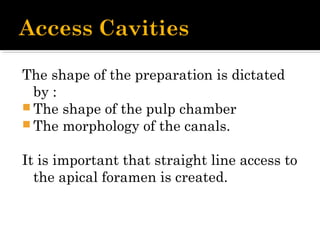Root canal anatomy and access cavities
- 2. ’éĪ Definition : Endodontics is the branch of dentistry dealing with diseases of the dental pulp.
- 3. ’éĪ The number of canals in a tooth correlates to the number of roots in a tooth. ’éĪ The space inside the root canals is filled with a highly vascularized and highly innervated loose connective tissue, called the dental pulp. ’éĪ The pulp tissue is in communication with the periodontium and the rest of the body through the apical foramen.
- 4. ’éĪ Central region contains nerves and blood vessels. ’éĪ Innermost layer, - contains fibroblasts and undifferentiated mesenchymal cells. ’éĪ Zone of Weil ŌĆō This is a cell free zone, rich in capillaries and nerve fibres. ’éĪ Odontoblastic layer ŌĆō outermost layer, contains odontoblasts and is next to the predetin and mature dentin.
- 5. ’éĪ Primary Function is to form Dentin ’éĪ Nutritive ŌĆō provides nutrients to the organic surroundings ’éĪ Sensory ŌĆō sensitive to temperature, pressure or trauma ’éĪ Protective ŌĆō forms secondary dentin, when under attack from bacteria.
- 7. ’éĪ Accessory canals are branches of the main canal that form a communication between the pulp and periodontum. ’éĪ They also contain vessels and nerves, and can be located anywhere between the level of furcation to the apex. ’éĪ 30% of lower incisors have lingual and labial canals. ’éĪ 85% of mesiobuccal roots contain two canals (MB1 and MB2), in upper molar teeth.
- 9. The shape of the preparation is dictated by : ’éĪ The shape of the pulp chamber ’éĪ The morphology of the canals. It is important that straight line access to the apical foramen is created.
- 10. ’éĪ The access cavity is initiated in the middle of the palatal side of the tooth. ’éĪ Initial preparation should be at 90┬░ to the palatal aspect of the tooth. ’éĪ Once dentine has been reached the angulation of the bur is changed to follow a long axis of the tooth using a slow handpiece.
- 11. ’éĪ Initial preparation is made in the middle of the fissure. The cavity is then extended buccally and palatally. ’éĪ NB : Marginal ridges must not be involved in this presentation, as this would compromise the integrity of the tooth.
- 12. ’éĪ Initial Preparation is done in the mesial pit. ’éĪ The cavity is then extended in the mesial half of the tooth to include all canals. ’éĪ The mesial marginal ridge must not be damaged in upper molars as the cavity should lay mesially to it. ’éĪ However lower molar teeth, have a distal canal, which is located just past the middle of the tooth.
- 16. Irrigation in Endodontic treatment serves the following purposes:┬Ā ’éĪ Lubricate canal ’éĪ Dissolve the pulp remnants ’éĪ Washing out debris created by canal instrumentation ’éĪ Kill/remove the bacteria/micro- organisms in root canal ’éĪ Clean the smear layer
- 17. ’éĪ Sodium Hypochlorite :Dissolves necrotic tissue and kills bacteria quite effectively. ’éĪ Kills bacteria quite effectively.┬Ā ’éĪ Chelators: Such as EDTA, remove the smear layer. ’éĪ Hydrogen Peroxide: Used to be used a lot, however studies have shown it to be ineffective. ’éĪ Chlorhexidine: Has been shown to remove significant number of bacteria.
- 18. ’éĪ ENDOVAC TECHNOLOGY ŌĆō the use of apical negative pressure irrigation, significantly improves cleaning and disinfection more closely to the apex. ’éĪ ENDOACTIVATOR ŌĆō Sonically driven system, enables the irrigant to travel deep into the pulpal system, enabling better cleaning.
- 19. ’éĪ Tooth Anatomy ŌĆō Revision ’éĪ Root canal anatomy ’éĪ Accessory canals ’éĪ Access cavities ’éĪ Irrigants ’éĪ Recent Developments in Endodontics.
- 20. ’éĪ http://www.dentistrytoday.com/endodon tics/1043 ’éĪ http://www.youtube.com/watch? v=QrUgCNQs038 ’éĪ Endodontics Lecture from Blackboard. By Dr Qualtrough. ’éĪ http://www.dentistrytoday.info/content/i rrigation-endo ’éĪ http://www.jendodon.com/article/S0099- 2399(07)00095-7/abstract




















